A New Continuous Flow Microwave Radiation Process Design for Non-Isocyanate Polyurethane (NIPU)
Abstract
:1. Introduction
2. Materials and Methods
2.1. Materials
2.2. Instrumentation
2.3. Preparations
2.3.1. BABCC from Reaction of BADGE with Carbon Dioxide
2.3.2. Ring-Opening Reaction of BABCC with Jeffamine-D2000 in Oil Bath
2.3.3. Ring-Opening Reaction of BABCC with Jeffamine-D2000 by Microwave Synthesizer
2.3.4. Batch Reaction of BABCC with Jeffamine-D2000 in a Mars 6 Microwave Synthesizer
2.3.5. Continuous MW Radiation of BABCC with Jeffamine-D2000 in a Recirculating Flow Tube Reactor
2.3.6. Continuous Microwave Radiation Flow Tube Reactor
3. Results
3.1. Analysis of BABCC
3.1.1. FT-IR
3.1.2. NMR
3.2. Analysis of NIPU
3.2.1. Results of FTIR Analysis for Batch System
3.2.2. Results of FTIR Analysis in Continuous and Recirculating Flow System
3.2.3. Heating Method
3.2.4. Energy Consumption Comparison
4. Conclusions
5. Patents
Author Contributions
Funding
Institutional Review Board Statement
Data Availability Statement
Acknowledgments
Conflicts of Interest
References
- Islam, M.R.; Beg, M.D.H.; Jamari, S.S. Development of vegetable-oil-based polymers. J. Appl. Polym. Sci. 2014, 131, 9016–9028. [Google Scholar] [CrossRef] [Green Version]
- Delebecq, E.; Pascault, J.P.; Boutevin, B.; Ganachaud, F. On the versatility of urethane/urea bonds: Reversibility, blocked isocyanate, and non-isocyanate polyurethane. Chem. Rev. 2013, 113, 80–118. [Google Scholar] [CrossRef] [PubMed]
- Polyurethane market by raw material (MDI, TDI, polyols), product (coatings, adhesives & sealants, flexible & rigid foams, elastomers), end user (building & construction, automotive & transportation, bedding & furniture)—Global forecast to 2021. Mark. Res. Rep. 2017, 4737.
- Seymour, R.B.; Kauffman, G.B. Polyurethanes: A class of modern versatile materials. J. Chem. Educ. 1992, 69, 909–910. [Google Scholar] [CrossRef]
- Petrović, Z.S.; Ferguson, J. Polyurethane elastomers. Prog. Polym. Sci. 1991, 16, 695–836. [Google Scholar] [CrossRef]
- Chattopadhyay, D.K.; Raju, K.V.S.N. Structural engineering of polyurethane coatings for high performance applications. Prog. Polym. Sci. 2007, 32, 352–418. [Google Scholar] [CrossRef]
- Rafiee, Z.; Keshavarz, V. Synthesis and characterization of polyurethane/ microcrystalline cellulose bionanocomposites. Prog. Org. Coat. 2015, 86, 190–193. [Google Scholar] [CrossRef]
- Tersac, G. Chemistry and technology of polyols for polyurethanes. Milhail Ionescu. Rapra Technology, Shrewsbury, UK. Polym. Int. 2007, 56, 820. [Google Scholar] [CrossRef]
- Hentschel, W. Phenylcyanat und Salzsäure. Ber. Dtsch. Chem. Ges. 1985, 18, 1178. [Google Scholar] [CrossRef] [Green Version]
- Oertel, G. Polyurethane handbook. Reinf. Plast. 1986, 30, 51. [Google Scholar]
- Srichatrapimuk, V.W.; Cooper, S.L. Infrared thermal analysis of polyurethane block polymers. J. Macromol. Sci. Part B Phys. 1987, 15, 267–311. [Google Scholar] [CrossRef]
- Kihara, N.; Hara, N.; Endo, T. Catalytic activity of various salts in the reaction of 2, 3-epoxypropyl phenyl ether and carbon dioxide under atmospheric pressure. J. Org. Chem. 1993, 58, 6198–6202. [Google Scholar] [CrossRef]
- Kihara, N.; Kushida, Y.; Endo, T. Optically active poly(hydroxyurethane)s derived from cyclic carbonate and L-lysine derivatives. J. Polym. Sci. A Polym. Chem. 1996, 34, 2173–2179. [Google Scholar] [CrossRef]
- Gedye, R.; Smith, F.; Westaway, K.; Ali, H.; Baldisera, L.; Laberge, L.; Rousell, J. The use of microwave ovens for rapid organic synthesis. Tetrahedron Lett. 1986, 27, 279–282. [Google Scholar] [CrossRef]
- Giguere, R.J.; Bray, T.L.; Duncan, S.M.; Majetich, G. Application of commercial microwave ovens to organic synthesis. Tetrahedron Lett. 1986, 27, 4945–4948. [Google Scholar] [CrossRef]
- Leadbeater, N.E.; Marco, M. Ligand-free palladium catalysis of the Suzuki reaction in water using microwave heating. Org. Lett. 2002, 4, 2973–2976. [Google Scholar] [CrossRef]
- Leadbeater, N.E.; Marco, M. Transition-Metal-Free Suzuki-Type Coupling Reactions. Angew. Chem. 2003, 42, 1407–1409. [Google Scholar] [CrossRef]
- Leadbeater, N.E.; Marco, M. Transition-metal-free Suzuki-type coupling reactions: Scope and limitations of the methodology. J. Org. Chem. 2003, 68, 5660–5667. [Google Scholar] [CrossRef]
- Kaval, N.; Dehaen, W.; Kappe, C.O.; Van der Eycken, E. The effect of pressure on microwave-enhanced Diels–Alder reactions. A Case Study. Org. Biomol. Chem. 2004, 2, 154–156. [Google Scholar] [CrossRef]
- Baxendale, I.R.; Lee, A.L.; Ley, S.V. A concise synthesis of carpanone using solid-supported reagents and scavengers. J. Chem. Soc. Perkin Trans. 1 2002, 16, 1850–1857. [Google Scholar] [CrossRef]
- Stadlbauer, W.; Schmut, O.; Kappe, T. Synthesis of benzofuranes by cyclodehydrogenation of phenylmalonyl heterocyclic compounds. Monatsh. Chem. 1980, 111, 1005–1013. [Google Scholar] [CrossRef]
- Lange, J.H.; Verveer, P.C.; Osnabrug, S.J.; Visser, G.M. Rapid microwave-enhanced synthesis of 4-hydroxyquinolinones under solvent-free conditions. Tetrahedron Lett. 2001, 42, 1367–1369. [Google Scholar] [CrossRef]
- Trost, B.M.; Andersen, N.G. Utilization of molybdenum-and palladium-catayzed dynamic kinetic asymmetric transformations for the preparation of tertiary and quaternary stereogenic centers: A concise synthesis of tipranavir. J. Am. Chem. Soc. 2002, 124, 14320–14321. [Google Scholar] [CrossRef]
- Dupau, P.; Epple, R.; Thomas, A.A.; Fokin, V.V.; Sharpless, K.B. Osmium-catalyzed dihydroxylation of olefins in acidic media: Old process, new tricks. Adv. Synth. Catal. 2002, 344, 421–433. [Google Scholar] [CrossRef]
- Steinreiber, A.; Stadler, A.; Mayer, S.F.; Faber, K.; Kappe, C.O. High-speed microwave-promoted Mitsunobu inversions. Application toward the deracemization of sulcatol. Tetrahedron Lett. 2001, 42, 6283–6286. [Google Scholar] [CrossRef]
- Lampariello, L.R.; Piras, D.; Rodriquez, M.; Taddei, M. Solid-phase synthesis of conformationally constrained peptidomimetics based on a 3, 6-disubstituted-1, 4-diazepan-2, 5-dione core. J. Org. Chem. 2003, 68, 7893–7895. [Google Scholar] [CrossRef]
- Raheem, I.T.; Goodman, S.N.; Jacobsen, E.N. Catalytic asymmetric total syntheses of quinine and quinidine. J. Am. Chem. Soc. 2004, 126, 706–707. [Google Scholar] [CrossRef]
- Cherng, Y.J. Efficient nucleophilic substitution reaction of aryl halides with amino acids under focused microwave irradiation. Tetrahedron 2000, 56, 8287–8289. [Google Scholar] [CrossRef]
- Brown, G.R.; Foubister, A.J.; Roberts, C.A.; Wells, S.L.; Wood, R. Improved yields of meta-amination and symmetrical and unsymmetrical diamination of benzenes. Tetrahedron Lett. 2001, 42, 3917–3919. [Google Scholar] [CrossRef]
- Cherng, Y.J. Efficient nucleophilic substitution reactions of pyrimidyl and pyrazyl halides with nucleophiles under focused microwave irradiation. Tetrahedron 2002, 58, 887–890. [Google Scholar] [CrossRef]
- Cablewski, T.; Faux, A.F.; Strauss, C.R. Development and application of a continuous microwave reactor for organic synthesis. J. Org. Chem. 1994, 59, 3408–3412. [Google Scholar] [CrossRef]
- Correa, R.; Gonzalez, G.; Dougar, V. Emulsion polymerization in a microwave reactor. Polymer 1998, 39, 1471–1474. [Google Scholar] [CrossRef]
- Bogdal, D.; Galica, M.; Bartus, G.; Wolinski, J.; Wronski, S. Preparation of polymers under phase-transfer catalytic conditions. Org. Process Res. Dev. 2010, 14, 669–683. [Google Scholar] [CrossRef]
- Muley, P.D.; Boldor, D. Scale-up of a continuous microwave-assisted transesterification process of soybean oil for biodiesel production. Trans. ASABE 2013, 56, 1847–1854. [Google Scholar]
- Hwang, J.Z.; Chen, C.L.; Huang, C.Y.; Yeh, J.T.; Chen, K.N. Green PU resin from an accelerated non-isocyanate process with microwave radiation. J. Polym. Res. 2013, 20, 195. [Google Scholar] [CrossRef]
- Quérette, T.; Fleury, E.; Sintes-Zydowicz, N. Non-isocyanate polyurethane nanoparticles prepared by nanoprecipitation. Eur. Polym. J. 2019, 114, 434–445. [Google Scholar] [CrossRef]
- Razali, N.I.M.; Ali, F.; Azmi, A.S.; Ismail, T.N.M.T.; Anuar, H.; Jamaluddin, J. Polyurethane: Green chemistry synthesis, application and biodegradability–A review. J. Polym. Sci. Technol. 2022, 7, 13–30. [Google Scholar]
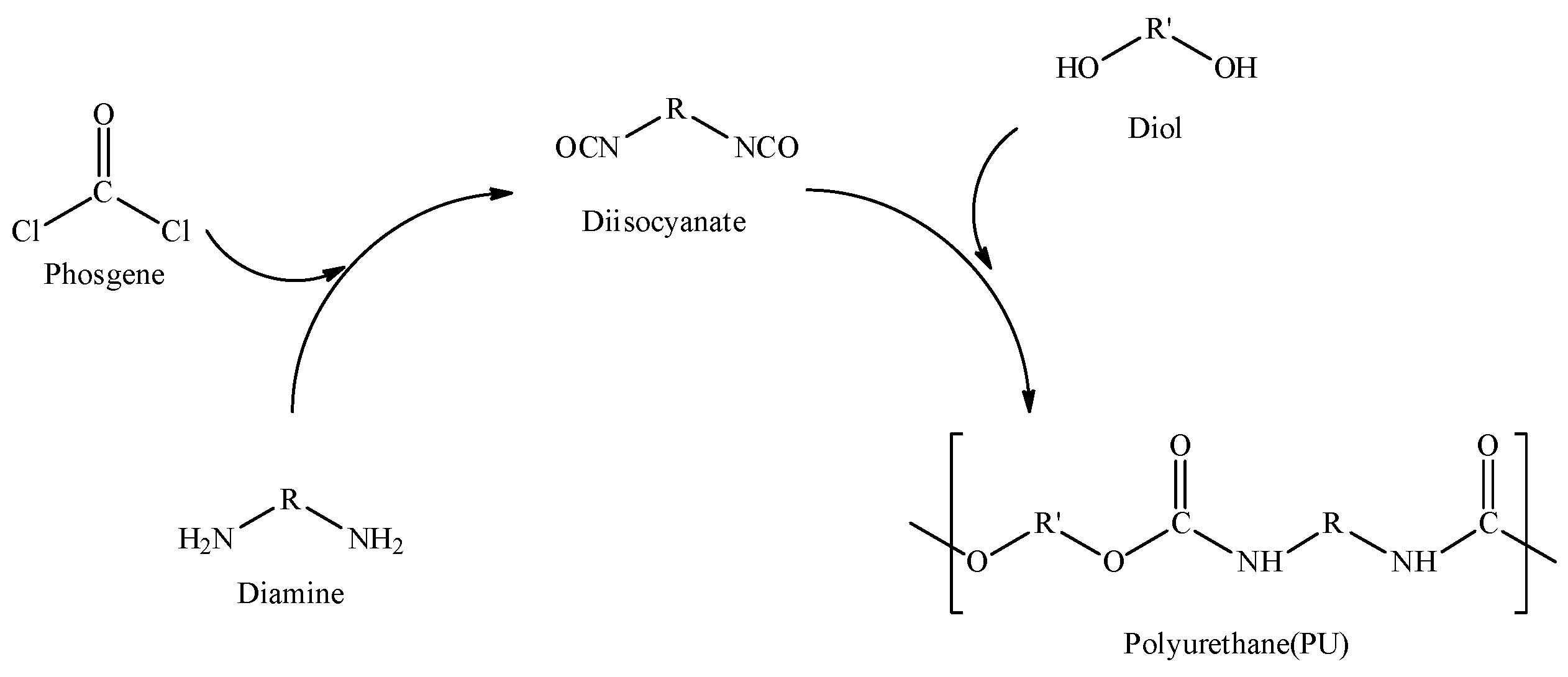
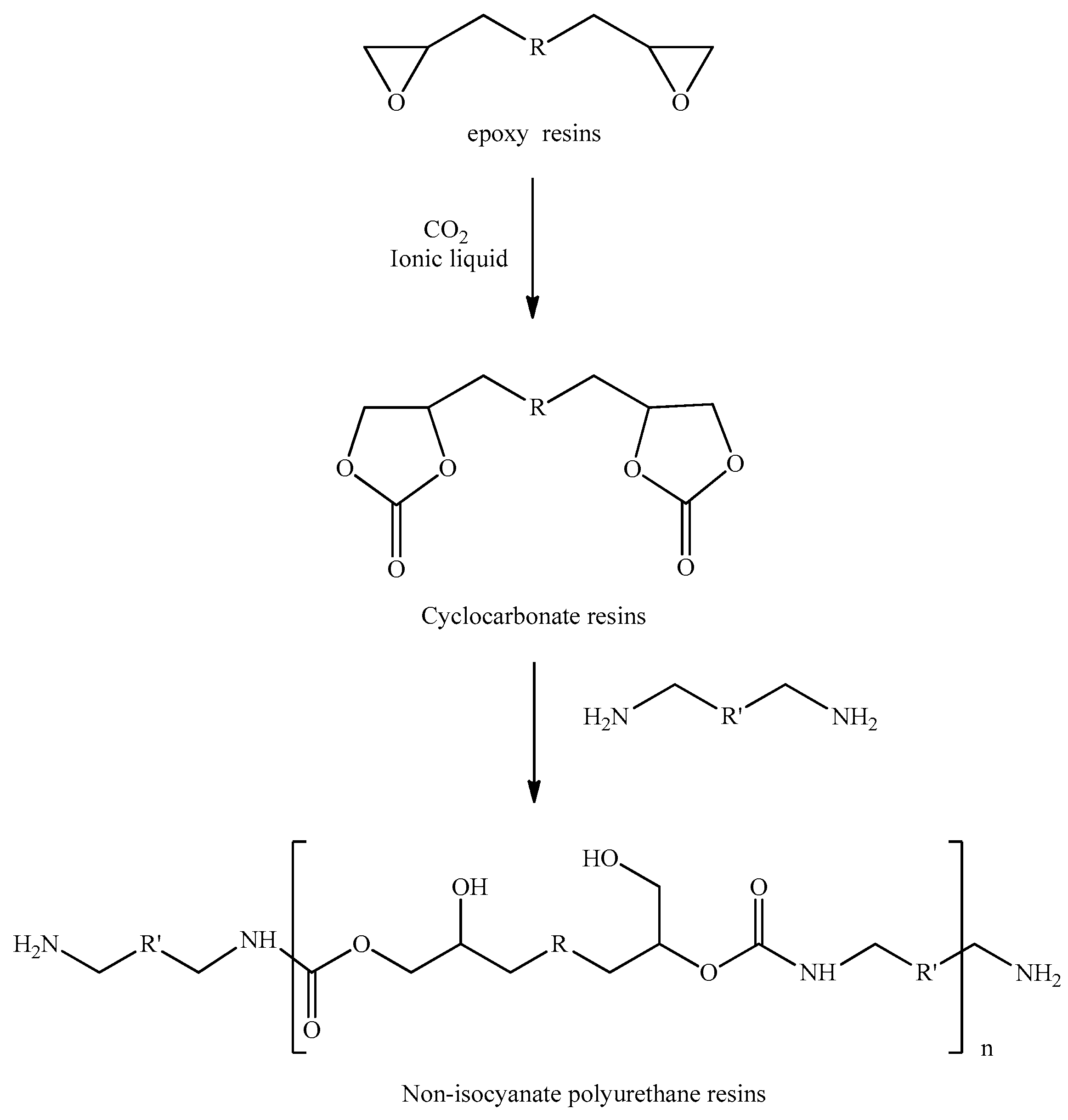
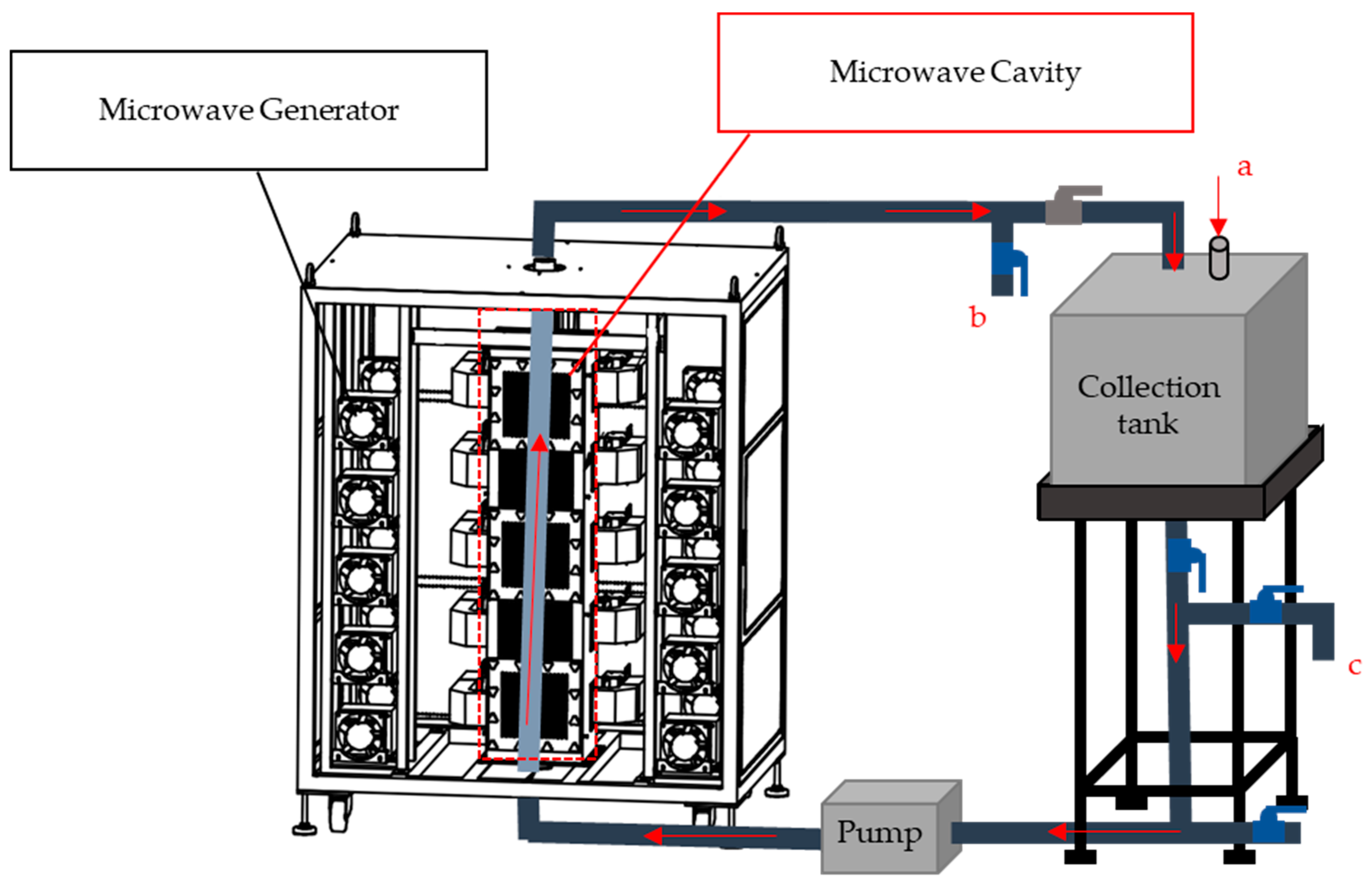
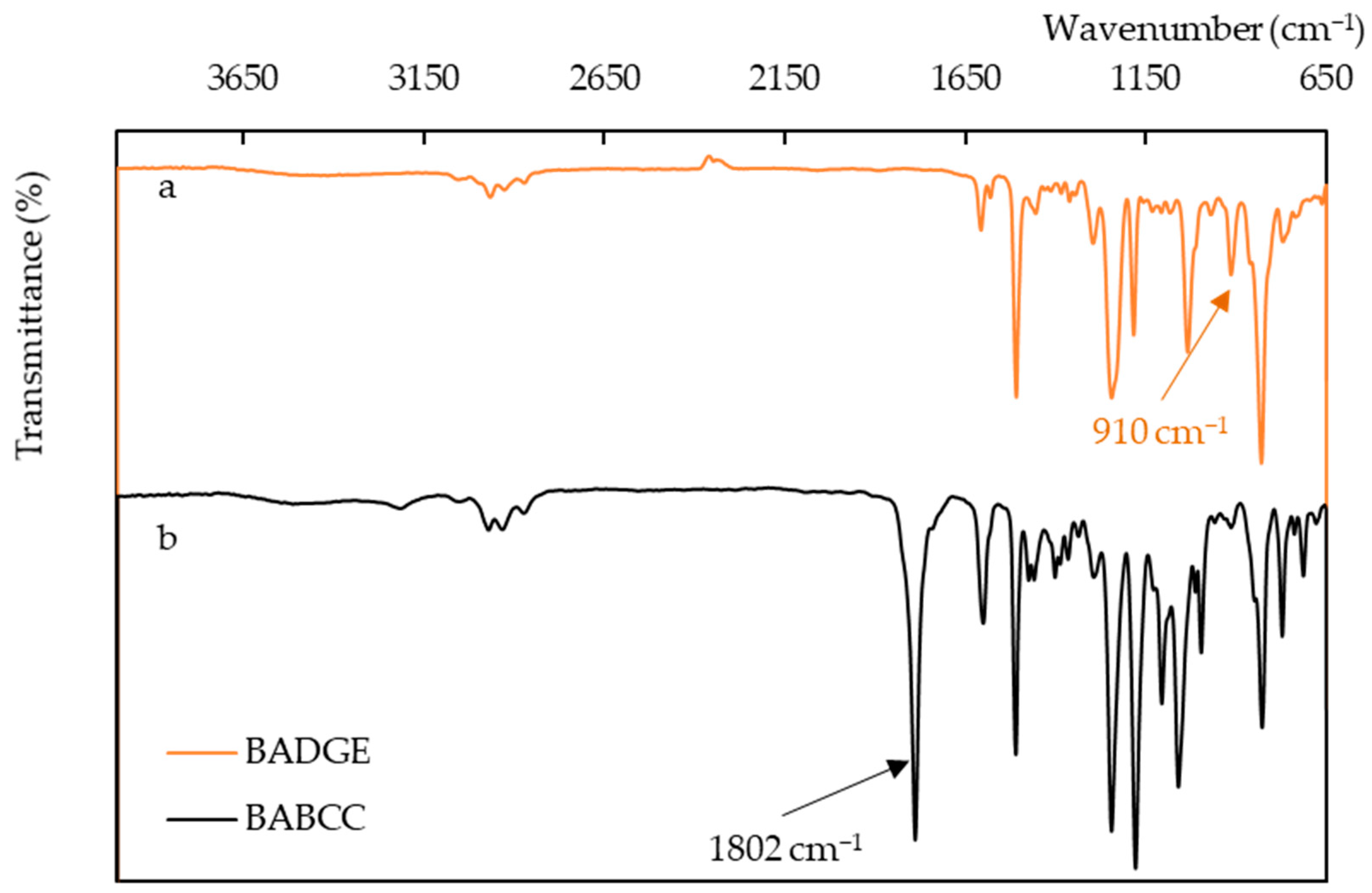

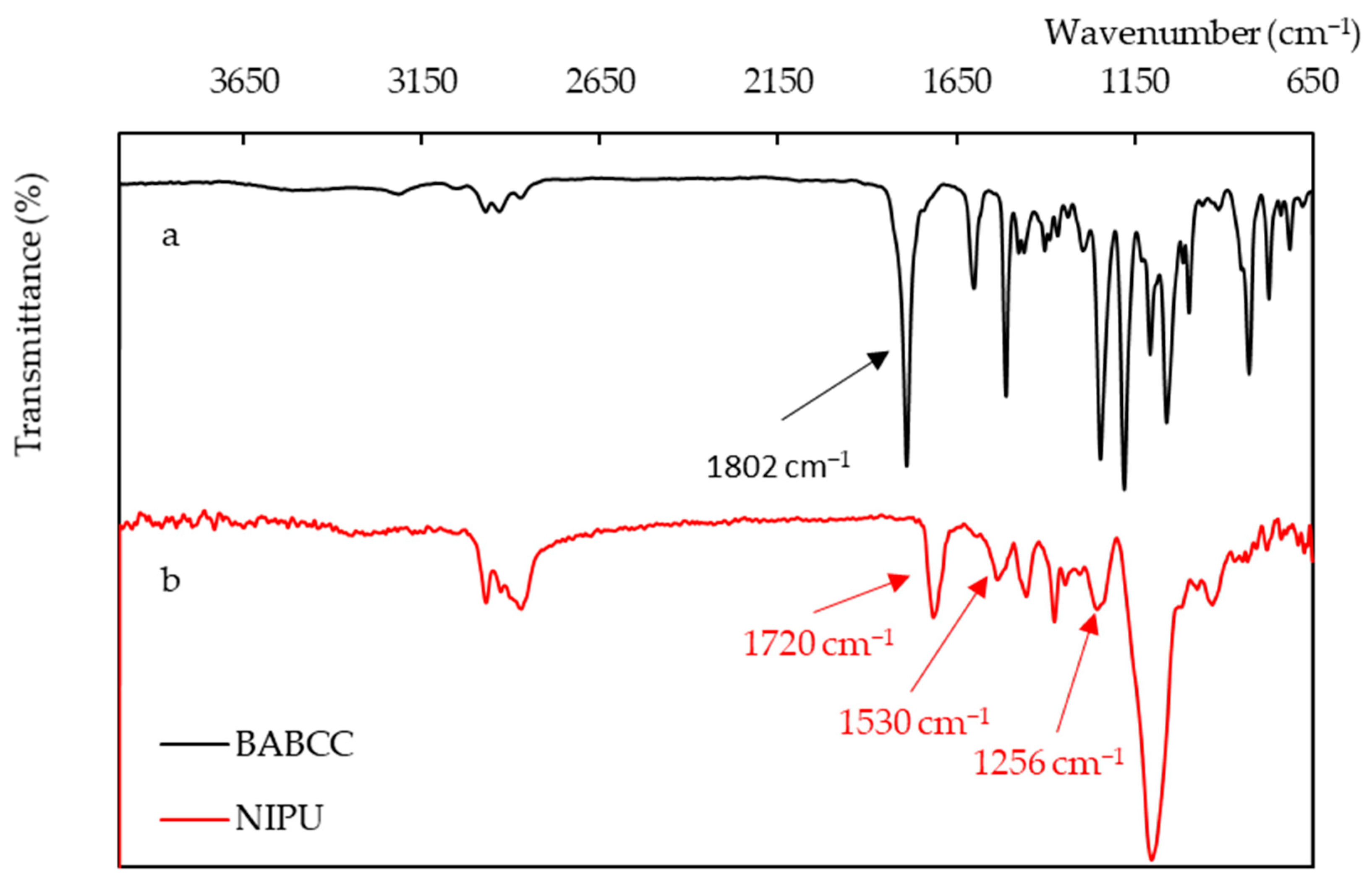
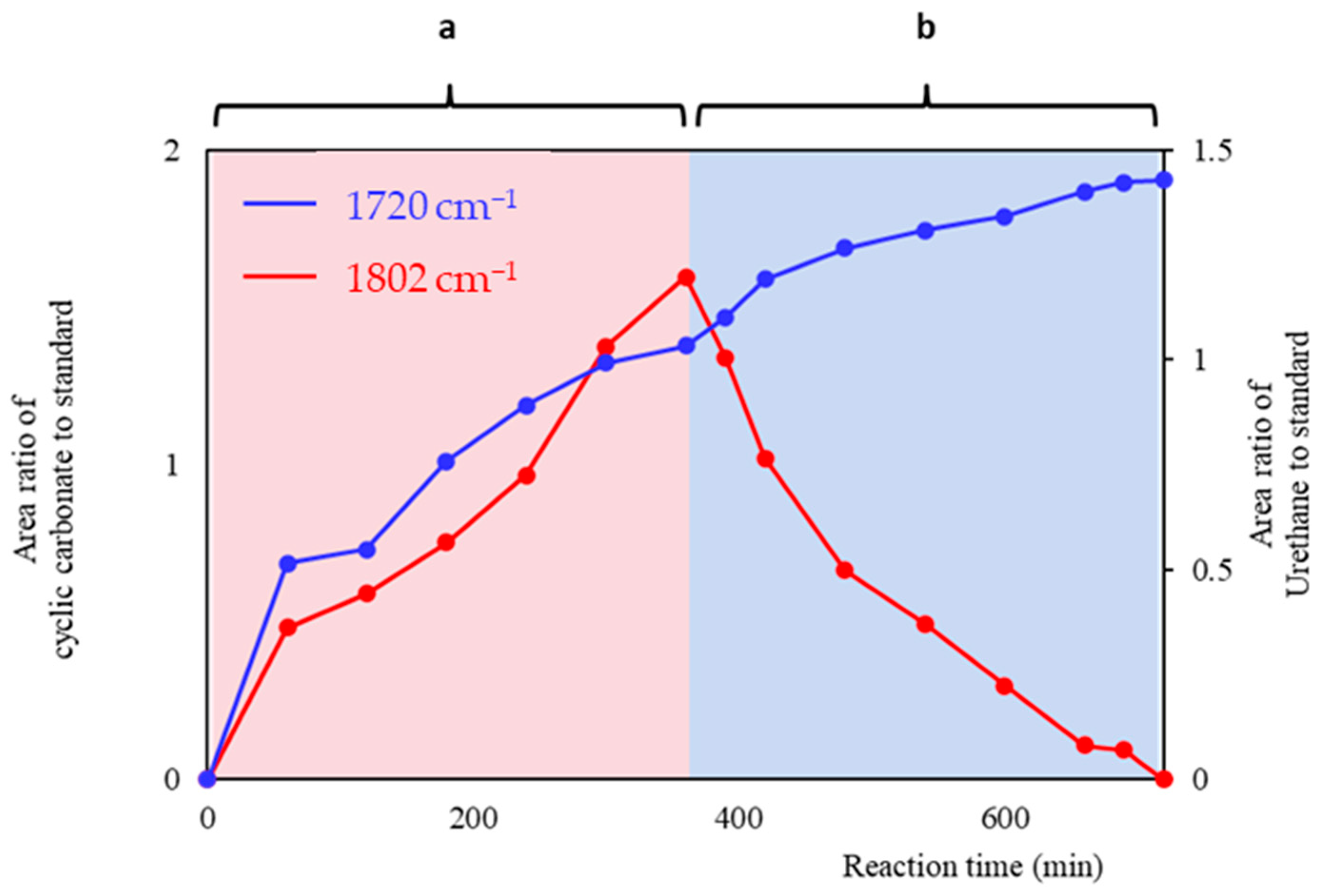
| Reaction Condition | Reactants (g) | Time (h) | Temperature (°C) | Flow Rate (L/min) | Productivity (g/h) | |
|---|---|---|---|---|---|---|
| entry 1 | Oil bath | 24.61 | 48 | 130 | - | 0.51 |
| entry 2 | Discover | 24.61 | 1 | 130 | - | 24.6 |
| entry 3 | Mars 6 | 246.30 | 2 | 130 | - | 123 |
| entry 4 | Continuous flow system | 7452.06 | 11 | 125–145 | 3.6 | 677 |
| entry 5 | Continuous flow system | 7452.06 | 11 | 125–145 | 4.8 | 677 |
| Reaction Condition | Reactants (g) | Time (h) | Flow Rate (L/min) | Total Energy Consumption (kJ) | Turn over Energy c (kJ/g) | |
|---|---|---|---|---|---|---|
| entry 2 | Discover | 24.61 | 1 | - | 600 a | 24.38 |
| entry 3 | Mars 6 | 246.30 | 2 | - | 3660 a | 14.86 |
| entry 4 | Continuous flow system | 7452.06 | 11 | 3.6 | 66,254 b | 8.89 |
| entry 5 | Continuous flow system | 7452.06 | 11 | 4.8 | 65,427 b | 8.78 |
Disclaimer/Publisher’s Note: The statements, opinions and data contained in all publications are solely those of the individual author(s) and contributor(s) and not of MDPI and/or the editor(s). MDPI and/or the editor(s) disclaim responsibility for any injury to people or property resulting from any ideas, methods, instructions or products referred to in the content. |
© 2023 by the authors. Licensee MDPI, Basel, Switzerland. This article is an open access article distributed under the terms and conditions of the Creative Commons Attribution (CC BY) license (https://creativecommons.org/licenses/by/4.0/).
Share and Cite
Yang, P.-L.; Tsai, S.-H.; Chen, K.-N.; Wong, D.S.-H. A New Continuous Flow Microwave Radiation Process Design for Non-Isocyanate Polyurethane (NIPU). Polymers 2023, 15, 2499. https://doi.org/10.3390/polym15112499
Yang P-L, Tsai S-H, Chen K-N, Wong DS-H. A New Continuous Flow Microwave Radiation Process Design for Non-Isocyanate Polyurethane (NIPU). Polymers. 2023; 15(11):2499. https://doi.org/10.3390/polym15112499
Chicago/Turabian StyleYang, Ping-Lin, Sung-Han Tsai, Kan-Nan Chen, and David Shan-Hill Wong. 2023. "A New Continuous Flow Microwave Radiation Process Design for Non-Isocyanate Polyurethane (NIPU)" Polymers 15, no. 11: 2499. https://doi.org/10.3390/polym15112499





